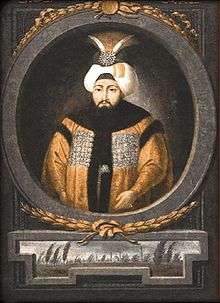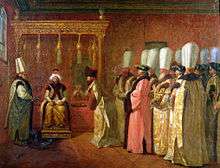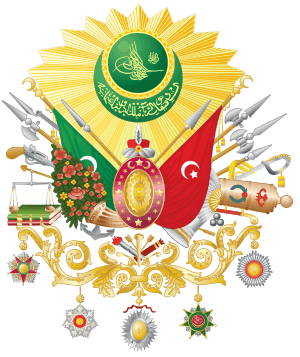Osman III
Osman III (Ottoman Turkish: عثمان ثالث ‘Osmān-i sālis; 2 January 1699 – 30 October 1757) was the Sultan of the Ottoman Empire from 1754 to 1757.[4]
| Osman III عثمان ثالث | |||||
|---|---|---|---|---|---|
| Ottoman Caliph Sultan of the Ottoman Empire Kayser-i Rûm(Caesar of Rome) Custodian of the Two Holy Mosques | |||||
 | |||||
| 25th Ottoman Sultan (Emperor) | |||||
| Reign | 13 December 1754 – 30 October 1757 | ||||
| Predecessor | Mahmud I | ||||
| Successor | Mustafa III | ||||
| Born | 2 January 1699 Edirne Palace, Edirne, Ottoman Empire | ||||
| Died | 30 October 1757 (aged 58) Topkapı Palace, Istanbul, Ottoman Empire | ||||
| Burial | Tomb of Turhan Sultan, New Mosque, Istanbul | ||||
| Consorts | Leyla Kadın[1] Zevki Kadın[2] Nefise Kadın[3] Ferhunde Kadın[2] one another wife | ||||
| |||||
| Dynasty | Ottoman | ||||
| Father | Mustafa II | ||||
| Mother | Şehsuvar Sultan | ||||
| Religion | Sunni Islam | ||||
| Tughra | |||||
Early life
Osman III was born on 2 January 1699 in the Edirne Palace, his father was Mustafa II and his mother was Şehsuvar Sultan, he was younger half-brother of Mahmud I. When his father was deposed from the throne in 1703 he was taken back to Istanbul and was imprisoned in the Kafes, he lived in Kafes for 51 years. [5]
He was secretly circumcised on 17 April 1705 with other princes here. He was among the princes in Ahmed's entourage. He also later made trips to the sultan inside and outside the city. Together with his elder brother Mahmud's embassy on October 1, 1730, he became the biggest prince waiting for the throne.[6]
Reign
Osman III lived most of his life as a prisoner in the palace, and as a consequence on becoming Sultan he had some behavioural peculiarities. Unlike previous Sultans, he hated music, and banished all musicians from the palace.

Osman III's first activity was to choose the ones to work with. During his reign, the changes he made in high-level government duties, especially Grand Vizier, can be considered as attempts to reduce the extremely weighted role of the charitable authority in the previous sultan's era.[6]
In the severe storm of March 1756, an Egyptian galleon ran ashore in Kumkapi at dusk. Due to the storm, 600 passengers could not be evacuated. The sultan, who came to the shore, took all the passengers by bringing barges from the shipyard. He ordered the construction of a lighthouse in Ahırkapı to prevent such incidents. [7] According to Baron de Tott, Osman III was an angry and modest type of ruler. [8]
The first procession of his enthronement was held on 14 December 1754. The historians of that time didn’t wrote the events happened in the empire because of severe and freezing cold of January 1755. [9] Osman was responsible for a firman in 1757, that preserved the Status Quo of various Holy Land sites for Christians, Muslims, and Jews.[10]
In the second year of his reign, Osman lost his mother Şehsuvar Sultan, who had been in contact with his religiousness. Then, the biggest prince, Mehmed died of illness of 22 December 1756. According to the sources, the funeral of the prince, controlled by the quarry, grand vizier and sheikh al-Islam, was made with a large congregation attended by 5000 people. The news of contemporary works that the prince was poisoned and killed by the initiative of Köse Mustafa Pasha, the next sultan of the third sultan, Köse Mustafa Pasha.[6]
It is noted that in this period, provisions were sent against banditry in Anatolia and Rumelia, and especially the movements of headless beams, and that the sultan was also interested in these issues. Some measures were taken against the tribes of Bozulus and Cihanbeyli, the Armenians due to the turmoil in Iran, the bandit around Erzurum and Sivas, and the famous leader Karaosmanoğlu Hacı Mustafa Ağa was captured and executed, and his head was brought to Istanbul on 5 December 1755.[6]
Architecture
Osman is famous for building Nuruosmaniye Mosque, whose construction started during the reign of Mahmud I. Nuruosmaniye Complex, also known as Osmaniye for a while, consisted of three schools, madrasahs, production, library, mausoleum, temporary room, mesh house, fountain, fountain, inn and shops. Osman built a new neighborhood in 1755-56 where Üsküdar Palace and Garden was located, along with its houses and shops, and built the Ihsaniye Mosque and its masjids, both of which stand today as İhsaniye.[6]
Osman III contrived a fountain in his name in 1755-56 and the fountain was destroyed after 122 years after its construction. [11]
Death
He died on the night of 30 October 1757. In the early morning, his cousin ceremony was held and his cousin Mustafa III was placed on the throne. The new sultan ordered Osman to be buried in the New Mosque Mausoleum, not in Nuruosmaniye. [12]
In popular culture
- Turkish metal band Pentagram wrote a song about him called Lions In A Cage.
References
- Tarih ve toplum: aylık ansiklopedik dergi - Volume 24. İletişim Yayınları/Perka A. Ş. p. 59.
- Uluçay, Mustafa Çağatay (2011). Padişahların kadınları ve kızları. Ankara, Ötüken.
- Kal'a, Ahmet; Tabakoğlu, Ahmet (1999). İstanbul su külliyâtı: İstanbul şer'iyye sicilleri : Mâ-i Lezı̂z defterleri 3 (1794-1797). İstanbul Araştırmaları Merkezi. p. 64. ISBN 978-9-758-21504-1.
- Upham, Edward (1829). "Chapter XV: OTHMAN III Twenty Fifth Reign H 1168 A.D. 1754". History of the Ottoman Empire from its Establishment till the Year 1828. Constable's Miscellany. XL. Original from Oxford University: Constable and Co. p. 260.
- Sakaoğlu 2015, p. 325.
- "OSMAN III عثمان (ö. 1171/1757) Osmanlı padişahı (1754-1757)". İslam Ansiklopedisi. Retrieved 13 April 2020.
- Sakaoğlu 2015, p. 330.
- Sakaoğlu 2015, p. 332.
- Sakaoğlu 2015, p. 327.
- Michael R. T. Dumper; Bruce E. Stanley (2007). Cities of the Middle East and North Africa: A Historical Encyclopedia. ABC-CLIO. p. 209. ISBN 978-1-57607-919-5. Retrieved 29 November 2012.
- Haskan 2001, p. 1160.
- Sakaoğlu 2015, p. 331.
Sources
- Haskan, Mehmet Nermi (2001). Yüzyıllar boyunca Üsküdar - Volume 3. Üsküdar Belediyesi. p. 1332. ISBN 978-9-759-76063-2.
- Sakaoğlu, Necdet (2015). Bu Mülkün Sultanları. Alfa Yayıncılık. ISBN 978-6-051-71080-8.
External links
![]()
Osman III House of Osman Born: 2 January 1699 Died: 30 October 1757[aged 58] | ||
| Regnal titles | ||
|---|---|---|
| Preceded by Mahmud I |
Sultan of the Ottoman Empire 13 Dec 1754 – 30 Oct 1757 |
Succeeded by Mustafa III |
| Sunni Islam titles | ||
| Preceded by Mahmud I |
Caliph of the Ottoman Caliphate 13 Dec 1754 – 30 Oct 1757 |
Succeeded by Mustafa III |
